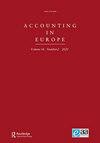Gaps in the IFRS Conceptual Framework
IF 4.3
Q1 BUSINESS, FINANCE
引用次数: 18
Abstract
Abstract The stated purpose of the IFRS Conceptual Framework is to assist the IASB to develop Standards that are based on consistent concepts, and also to assist preparers to develop consistent accounting policies when Standards either do not apply or allow a choice of accounting policy. Yet, the Framework actually does surprisingly little to help the IASB (or preparers) determine which assets, liabilities, income and expenses should be recognised, and how they should be measured. The Framework’s focus on assets and liabilities implies that the accounting can, and should, be determined from the balance sheet. Yet, many current financial reporting requirements focus initially on the income statement, and so they are not so much derived from the Framework as instead in need of being reconciled back to it. At its heart, the problem here is that, while the Framework states that accrual accounting provides a better basis for assessing past and future performance than cash-based information, it does not explain why. To do so would require a conceptualisation of how entities’ business models are employed to create value, and of the strengths and limitations of accounting data in enhancing investors’ understanding of that value-creation. The lack of explanation of the purpose and informational objectives of accruals, how they relate to business models and how they cause the income statement and the balance sheet to interact are gaps in the Framework. Filling those gaps would provide a more robust, and natural, way for the IASB to develop recognition and measurement requirements in its Standards.《国际财务报告准则》概念框架中的差距
摘要国际财务报告准则概念框架的既定目的是协助国际会计准则理事会制定基于一致概念的准则,并在准则不适用或允许选择会计政策时协助编制者制定一致的会计政策。然而,令人惊讶的是,该框架在帮助国际会计准则理事会(或编制者)确定哪些资产、负债、收入和支出应予以确认以及如何计量方面收效甚微。该框架对资产和负债的关注意味着会计可以而且应该根据资产负债表来确定。然而,目前的许多财务报告要求最初都集中在损益表上,因此与其说这些要求源自《框架》,不如说需要与《框架》进行对账。其核心问题是,尽管《框架》指出,权责发生制会计为评估过去和未来的业绩提供了比基于现金的信息更好的基础,它没有解释为什么。要做到这一点,需要对实体的商业模式如何被用来创造价值,以及会计数据在增强投资者对价值创造的理解方面的优势和局限性进行概念化。缺乏对应计项目的目的和信息目标、它们与商业模式的关系以及它们如何导致损益表和资产负债表相互作用的解释,是该框架中的空白。填补这些空白将为国际会计准则理事会在其标准中制定认可和衡量要求提供一种更有力、更自然的方式。
本文章由计算机程序翻译,如有差异,请以英文原文为准。
求助全文
约1分钟内获得全文
求助全文

 求助内容:
求助内容: 应助结果提醒方式:
应助结果提醒方式:


